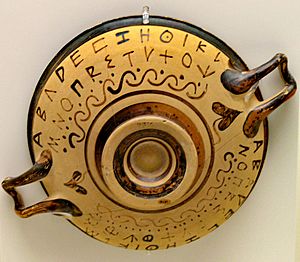Psi (Greek) facts for kids
Psi (pronounced "sy" as in "psychology") is the twenty-third letter of the Greek alphabet. It is almost the last letter in the alphabet. The uppercase letter looks like Ψ and the lowercase letter is ψ. In ancient Greece, Psi had a number value of 700.
In both ancient Greek and Modern Greek, the letter Psi makes a "ps" sound. You can hear this sound in English words like "lapse" or "psychology." When Greek words with Psi are used in English or Latin, the Psi is usually written as "ps."
Contents
Where Did Psi Come From?
We are not completely sure where the letter Psi came from. It might have come from the Phoenician alphabet, which was an early writing system. Psi first appeared around the 7th century BC (that's over 2,700 years ago!).
In the eastern parts of ancient Greece, Psi always made the "ps" sound. But in the western parts, it sometimes made a "kh" sound. The letter Χ (Chi) made the "kh" sound in the eastern areas.
Early versions of the letter Psi looked a bit different. Some were very angular, like a sharp V with a line through it. Others were shaped like a "chickenfoot," which means they didn't have the straight line at the bottom.
The western version of Psi was later used in the Old Italic alphabets. These were early alphabets used in Italy. Its shape also inspired a symbol called Algiz in the Elder Futhark, which was an ancient Germanic alphabet.
During the time of Emperor Claudius in ancient Rome, a special version of Psi was briefly used in the Latin alphabet. It was called "Antisigma." However, it was stopped after the emperor died. Later, the classical Greek letter Psi was adopted into the early Cyrillic alphabet. It became the letter "Ѱ" in that alphabet.
What Psi Is Used For Today
The letter Psi is used as a symbol in many different areas, especially in science and math.
Science and Math Symbols
- Physics: In quantum mechanics, Psi often stands for a "wave function." This is a mathematical way to describe tiny particles like electrons. It's used in important equations like the Schrödinger equation. Psi also represents the state of a qubit in a quantum computer.
- Mathematics: Psi can represent special math functions. One example is the polygamma function. It is also used for the reciprocal Fibonacci constant and the supergolden ratio.
- Biology: In biochemistry, Psi stands for pseudouridine. This is a special kind of building block found in RNA. In plant science, Psi can mean water potential. This describes how water moves between plant cells.
- Fluid Mechanics: In the study of how liquids and gases flow, Psi can represent a "stream function." This helps describe the path that flowing water or air takes.
- Proteins: In biochemistry, Psi is one of the dihedral angles. These angles describe the shape of the backbone of proteins, which are important molecules in our bodies.
- Particle Physics: The letter Psi is part of the name of a particle called the J/ψ meson.
Other Uses of Psi
- Psychology: The symbol Ψ is widely used for psychology. It also represents psychiatry and sometimes parapsychology. Parapsychology is the study of things like extrasensory perception (ESP).
- Astronomy: Psi can be a symbol for the planet Neptune.
- Universities: At Indiana University in the United States, the Psi symbol is used. It looks like a capital "I" and "U" put together.
- Weapons: The letter Psi sounds like "sai," which is the name of a cool weapon from Asia.
- Medicine: Psi is sometimes used as a general symbol for pharmacology and pharmacy.
- Biblical Studies: In studies of the Bible, Psi is a short way to refer to the book of Psalms.
Images for kids
See also
 In Spanish: Ψ para niños
In Spanish: Ψ para niños
- Psi and phi type figurine
- Psi (Cyrillic)





